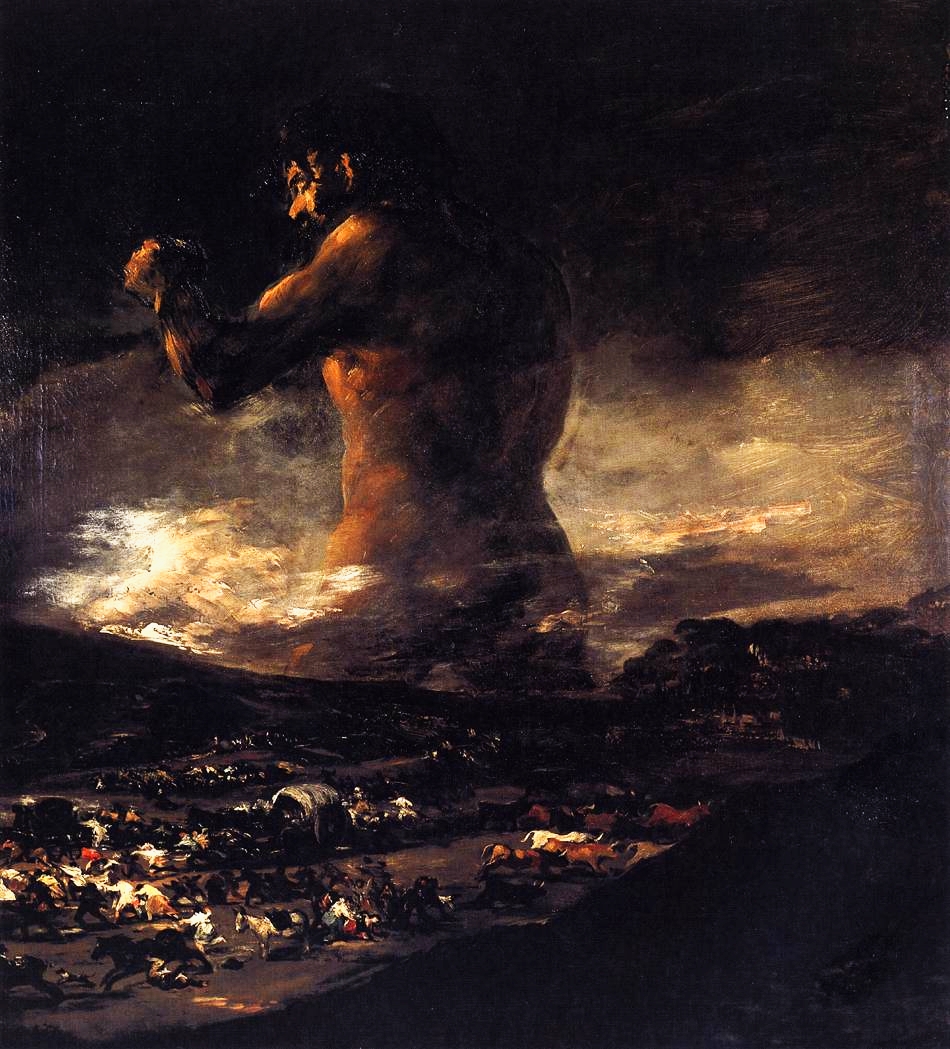Infobox Painting

image_size=230px
title=The Colossus
other_language_1=Spanish
other_title_1=El Coloso
artist=Asensio Juliá
year=1808-1812
type=Oil on canvas
height=116cm
width=105cm
city=Madrid
museum=Museo del Prado
"The Colossus" is a painting attributed to Francisco de Goya, painted between 1808 and 1812. It is also called "The Giant" in the inventory of Goya's goods in 1812, the year in which it became property of his son, Javier Goya. [This painting, according to Nigel Glendinning ("op. cit.", 1993, p. 140.) «was painted between this date [1808] and that of 1812, when the painted was inventories amongst those who became owned by the painter's son, after the death of this mother, Ms. Josefa Bayeu. The title of 'The Giant was given in this inventory [...] ».] Later it was owned by Pedro Fernández Durán, who passed his collection onto the Museo del Prado, where The Colossus has been kept since 1931.
A colossal sized giant among some mountains - which hide his legs up to the thighs - occupies the painting's centre, surrounded by clouds and his fists raised high. The lower part of the painting (about a third) is occupied by a gloomy valley where a crowd of people and cattle run in all directions.
The work has been interpreted in many ways, having received other names, including The Panic and The Storm.[ L. Cirlot (dir.), "Museo del Prado II", Col. «Museos del Mundo», Tomo 7, Espasa, 2007. ISBN 978-84-674-3810-9, pág. 83] ] Analysis
The enormous body of the giant takes up the centre of the composition. It seems to adopt an aggressive posture, judging by the position of the arm and the closed fist. The painting was painted during the Peninsular War, and could represent this war. Nigel Glendenning affirms that the painting is based in a patriotic poem by Juan Bautista Arriaza called "'The Pyrenean Prophecy". In this poem the Spanish population is presented as a giant emerging from the Pyrenees to confront the Napoleonic invasion.
The giant's attitude has been the object of various interpretations. It is not known whether he is walking or standing. His posture is also ambiguous; he could be amongst the mountains or buried up to his knees, in a similar vein to other Black Paintings such as "Fight With Cudgels". The giant's eyes are closed, which could represent blind violence.
Contrasting with the erect figure of the giant, small figures of the village people appear in the valley that seem to be fleeing in all directions, with the exception of a donkey which remains calm, which could symbolise, as Luna notes, the incomprension of war. [Juan J. Luna, «El coloso» [en línea] , in"Catalogue of the exposition in the Museo de Zaragoza from the 3rd October to the 1st December1996", [http://www.almendron.com/arte/pintura/goya/obras_goya/goya_43.htm nº 43: "El coloso".] ]
Doubts over Authorship
In 2008 [cite news | first=Danny | last=Wood | coauthors= | title= Spain gallery casts doubt on Goya | date=2008-06-26 | publisher=BBC | url =http://news.bbc.co.uk/2/hi/europe/7475405.stm | work =BBC News | pages = | accessdate = 2008-06-27 | language = ] , the Prado museum announced that there are reasons to suspect that the painting was actually painted by Asensio Juliá [cite news | first= | last= | coauthors= | title='El Coloso' "casi seguro" que no era de Goya | date= | publisher= | url =http://news.bbc.co.uk/2/hi/europe/7475405.stm | work =El País | pages = | accessdate = 2008-06-27 | language = Spanish ] , a collaborator of Goya's. The painting contains the initials "AJ" in the lower left hand corner. The painting was not included in a retrospective of Goya's works at the Prado.
After performing accurate studies of the painting for about 20 years, Manuela Mena, chief of the Prado Museum, who is also a Goya expert, came up with the conclusion that El Coloso was painted not in Francisco de Goya's style. She has also expressed her doubts regarding three other paintings of the famous artist. [ [http://www.infoniac.com/offbeat-news/goya-iconic-painting-not-created-by-genius.html Goya's Iconic Painting Not Created by the Genius?] ]
References

